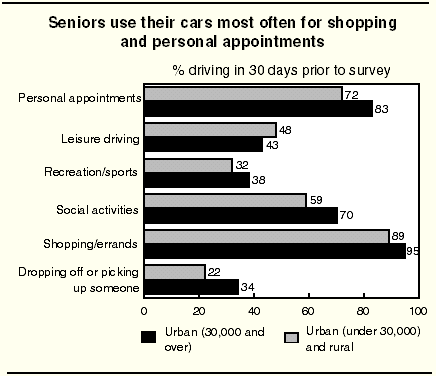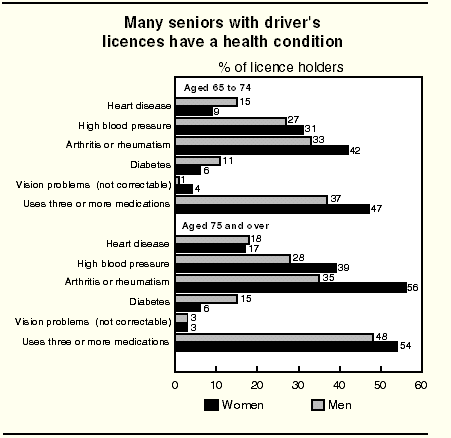 View the most recent version.
View the most recent version.Information identified as archived is provided for reference, research or recordkeeping purposes. It is not subject to the Government of Canada Web Standards and has not been altered or updated since it was archived. Please "contact us" to request a format other than those available.

The Daily. Thursday, September 9, 1999
In 1996, about one-half of Canadians aged 65 and over living in private households (about 1.7 million) were driving a car, minivan or truck. Seniors who lived in small towns and rural areas were more likely to be drivers: 60% compared with 46% of seniors in large urban centres. This is not surprising, considering that small towns and rural areas often have little or no public transit or special-needs transportation and their residents tend to live farther from basic amenities. As a result, to maintain their independence in performing routine tasks such as shopping and getting to personal appointments, seniors must rely more heavily on their cars.
Regardless of whether seniors were rural or urban residents, most people aged 65 and over drove only a few times a week. The majority of their trips were relatively short, with total distance travelled ranging from 11 to 17 km per day on average. Most often, seniors used their car for shopping, personal appointments such as visiting physicians, and family or social get-togethers. Relatively few older drivers used the car for long-distance trips or to pick up and drop off others.

|
Senior men - both rural and urban residents - were far more likely to drive than senior women. Results of the 1996 National Private Vehicle Use Survey indicate that in the majority (55%) of households where the husband held a valid licence, he was the exclusive driver of the household vehicle. Whether or not the wife had a licence made little difference - the husband still did the bulk of the driving.
The difference was most pronounced in small towns and rural areas, where 77% of husbands aged 65 and over drove the family car during the 30 days prior to the survey, over twice the rate of married older women (36%). In large urban centres, 65% of husbands drove compared with 37% of wives. Similar patterns, although not as pronounced, were observed for unmarried seniors: men were much more likely to sit behind the wheel.
The apparent lack of driving experience among women aged 65 and over may have important consequences, particularly in rural and suburban areas not served by public transit. Women tend to outlive their husbands; once alone, they may find that, unless they drive, they must significantly curtail their activities, pay for transportation or rely on friends and family for transportation. Any of these options could limit their ability to lead active, independent lives.
As time goes by, the independence offered by having a vehicle may be jeopardized by deteriorating health, which can affect the ability of some seniors to drive. For example, results of the 1996-97 National Population Health Survey showed that 35% of men and 56% of women aged 75 and over who had a driver's licence suffered from chronic arthritis or rheumatism, conditions that could make manoeuvres such as those required to make sharp turns or to merge with heavy traffic particularly difficult.

As well, roughly half of both male and female licence holders aged 75 and over were taking three or more medications around the time of the survey. The simultaneous use of multiple medications may result in slowing reaction time by that fraction of a second needed to avoid an accident. However, an Ontario government study found that, on the basis of kilometres driven, older drivers actually get into approximately the same number of accidents as their 16- to 24-year-old counterparts. Other studies have found that older drivers tend to compensate for these age-related health limitations by driving shorter distances and avoiding night driving, busy highways and downtown areas.
This release is based on an article in Canadian social trends (11-008-XPE, $11/$36; 11-008-XIE, $8/$27), which is now available. See How to order publications.
For more information, or to enquire about the concepts, methods or data quality of this release, contact Irwin Bess (613-951-9605), Transportation Division.